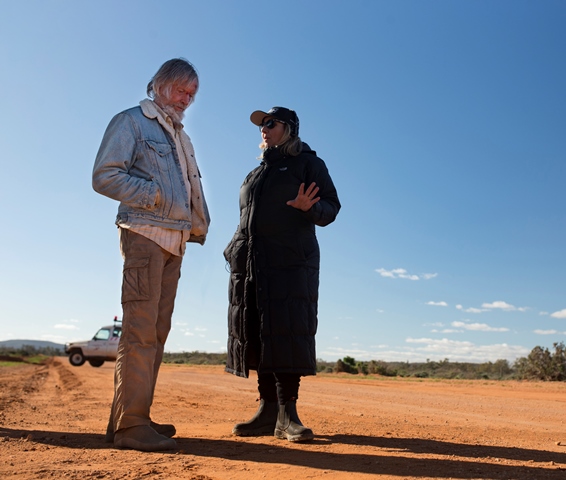(l-r) Scott Glenn and Mimi Leder on location in Broken Hill.
HBO’s critically acclaimed The Leftovers returns to Foxtel this week after shooting a large chunk of its third and final season in Australia last year.
The show tracks the impact of The Sudden Departure, in which two per cent of the world’s population vanished without a trace, on those left behind.
As the show’s regular director and EP Mimi Leder (Deep Impact) puts it: “If you’re going to do a show about the end of the world, what greater place to go to than Australia, which is practically at the end of the world to us (laughs).”
Leder and the production team, including creators Damon Lindelof (Lost) and Tom Perrotta (Little Children, Election), on whose novel the series is based, were inspired by the Australian films of the 70s.
“Season two was very much inspired by Picnic at Hanging Rock,” says Leder. “And The Last Wave, Wake in Fright, Walkabout. These films were inspiring to us because of their rawness, their primal feeling. There’s a sense of unease that The Leftovers has that those films really share.”
Leder and the producers scouted locations in Oz a year ago, travelling to Sydney and Adelaide before settling on Melbourne as a base.
Leder arrived in Oz after shooting the season’s first episode in Austin, Texas. “In Austin we shot and prepped from March to early May, and then we shut down for the move. I was in Australia for over five months, not counting the first scout.”
Based at Docklands but shooting also on location, the production briefly considered filming at Hanging Rock itself, but eventually opted to shoot at Victoria’s You Yangs mountain range.
Decamping to Australia meant hiring a new crew and adjusting to a ten-hour working day, down from the 12-14 hours that are customary in the States. “We just had to move fast, and the crew was fast,” says Leder.
The veteran director brought American DP John Grillo over and hired Australian cinematographer Robert Humphreys, using three ALEXA cameras to shoot each episode.
“And I brought over my A-camera operator Chris Cuevas and first assistant operator Liam Sinnott, and we hired Australian operators and watched films together and talked about our style. We do a lot of handheld, we do a lot of big scope shots; in Australia I really wanted to open [up] the show even more. We do a lot of long lens, and it was a learning curve as to how to shoot our show.”
Faced with the pressure of ending a series that has won increasing acclaim over the course of its run, Leder tried not to be “precious” about it.
“Everybody deals with endings differently. I tried not to do things differently. That’s deadly, once you start working out of fear. So I focused on the story, [and] what our finale was about.”
“The first season was about the event of The Departure, and season two was very much a reaction to The Departure – moving to Miracle, to a new town. Season three is really about the stories we tell ourselves. Our characters are looking for a story that gives meaning to their lives.”


